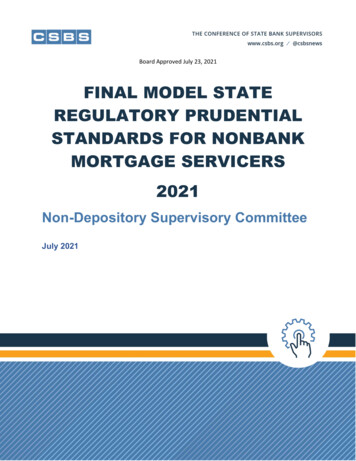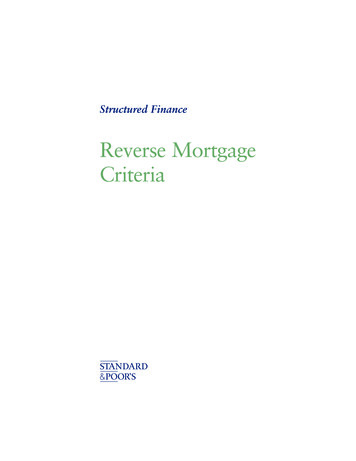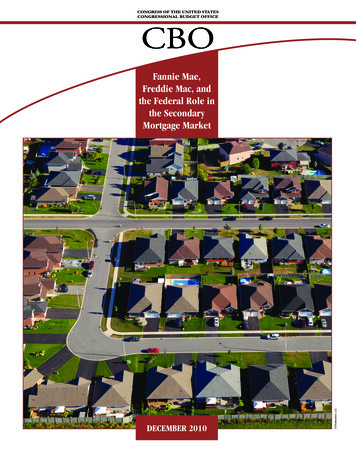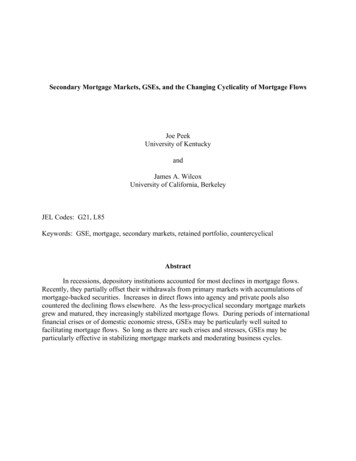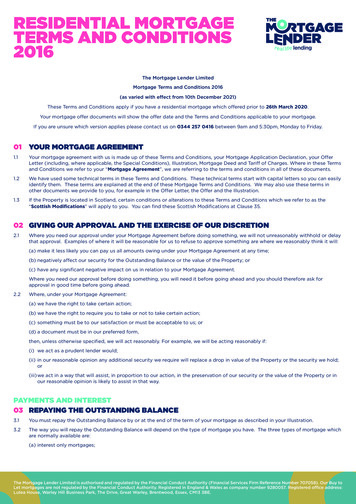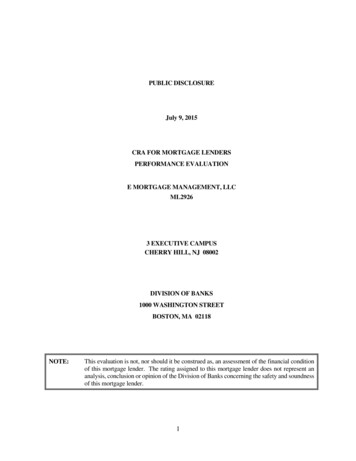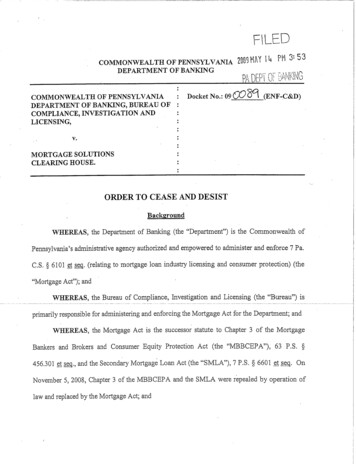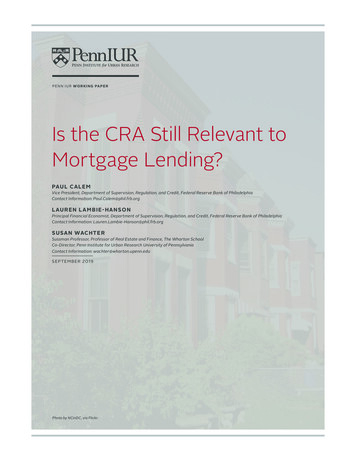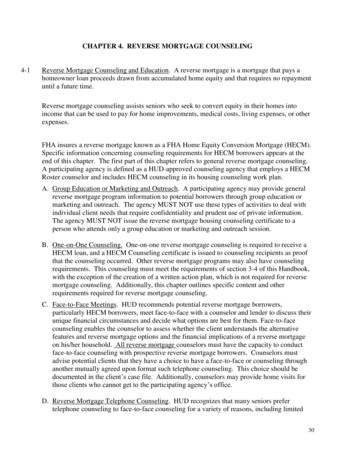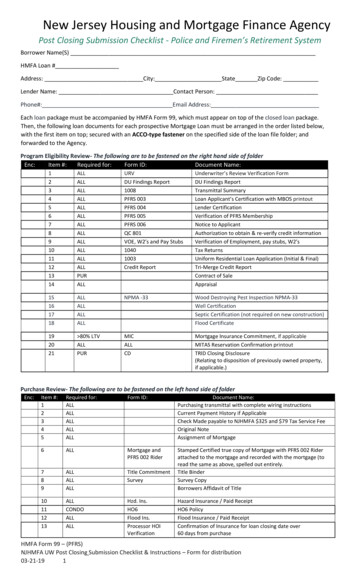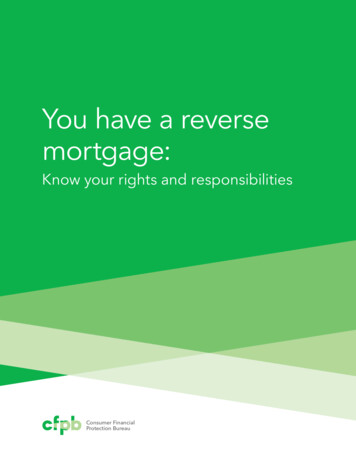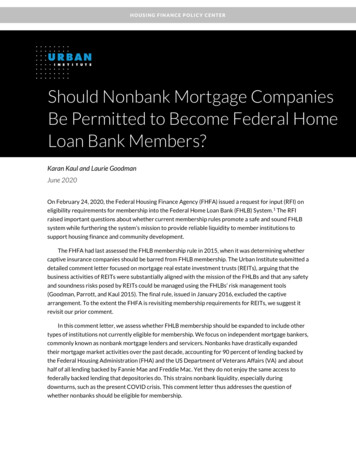
Transcription
HOUSING FINANCE POLICY CENTERShould Nonbank Mortgage CompaniesBe Permitted to Become Federal HomeLoan Bank Members?Karan Kaul and Laurie GoodmanJune 2020On February 24, 2020, the Federal Housing Finance Agency (FHFA) issued a request for input (RFI) oneligibility requirements for membership into the Federal Home Loan Bank (FHLB) System. 1 The RFIraised important questions about whether current membership rules promote a safe and sound FHLBsystem while furthering the system’s mission to provide reliable liquidity to member institutions tosupport housing finance and community development.The FHFA had last assessed the FHLB membership rule in 2015, when it was determining whethercaptive insurance companies should be barred from FHLB membership. The Urban Institute submitted adetailed comment letter focused on mortgage real estate investment trusts (REITs), arguing that thebusiness activities of REITs were substantially aligned with the mission of the FHLBs and that any safetyand soundness risks posed by REITs could be managed using the FHLBs’ risk management tools(Goodman, Parrott, and Kaul 2015). The final rule, issued in January 2016, excluded the captivearrangement. To the extent the FHFA is revisiting membership requirements for REITs, we suggest itrevisit our prior comment.In this comment letter, we assess whether FHLB membership should be expanded to include othertypes of institutions not currently eligible for membership. We focus on independent mortgage bankers,commonly known as nonbank mortgage lenders and servicers. Nonbanks have drastically expandedtheir mortgage market activities over the past decade, accounting for 90 percent of lending backed bythe Federal Housing Administration (FHA) and the US Department of Veterans Affairs (VA) and abouthalf of all lending backed by Fannie Mae and Freddie Mac. Yet they do not enjoy the same access tofederally backed lending that depositories do. This strains nonbank liquidity, especially duringdownturns, such as the present COVID crisis. This comment letter thus addresses the question ofwhether nonbanks should be eligible for membership.
In this brief, we evaluate the pros and cons of expanding FHLB membership to nonbanks, hurdlesthat stand in the way, and potential ways to overcome them. Consistent with the RFI, we break downour analysis into two buckets: (1) alignment of nonbank business activities with the housing mission ofthe FHLBs and (2) safety and soundness implications for the FHLBs.The brief is organized as follows. First, we elaborate on the role nonbanks play in the mortgagemarket and explain why their inclusion would further the FHLBs’ mission. We then explain key safetyand soundness implications of expanding membership to nonbanks. In the last section, we outlineadditional hurdles that would need to be addressed as part of the FHFA’s evaluation.How Well Do Nonbanks Alignwith the FHLBs’ Housing Mission?Leading up to the financial crisis, banking institutions dominated almost all segments of the mortgagemarket, including origination, servicing, and the secondary market. Since the financial crisis, however,depositories have ceded significant market share throughout the mortgage market to nonbanks.There are a few reasons for this shift (Kaul and Goodman 2016). Large depositories were heavilyexposed to loans made during the last housing bubble. As defaults mounted, many loans were subjectedto buybacks under Fannie Mae and Freddie Mac’s representations and warranties and the FHA’sindemnification policies. This forced banks to not only repurchase billions of dollars in troubled loansbut pay tens of billions of dollars in hefty fines and legal settlements. Worried about future litigation andreputational damage, banks curtailed their mortgage activities. Other factors that contributed to thispullback were higher capital requirements in the wake of the Great Recession, the unfavorabletreatment of mortgage servicing assets under the Basel III capital regime, and skyrocketing mortgageservicing and origination costs. Nonbanks—often smaller, nimbler, and less complex, with lowerregulatory, capital, and compliance costs—were well suited to step in.Nonbanks Play the Dominant Role in Originatingand Servicing Single-Family MortgagesThe nonbank share of originations for Fannie Mae, Freddie Mac, and Ginnie Mae has risen dramaticallyin recent years (figure 1). The increase has been broad based, spanning both conventional andgovernment channels and origination and servicing. Today, close to 90 percent of Ginnie Mae–backednew mortgages and about half of Fannie Mae– and Freddie Mac–backed new mortgages are originatedby nonbanks.2SHOULD NONBANKS BE PERMITTED TO BECOME FHLB MEMBERS?
FIGURE 1Nonbank Share of Agency Mortgage OriginationsAllFannie MaeFreddie MacGinnie 162017201820192020URBAN INSTITUTESource: Urban Institute calculations based on eMBS data.Additionally, because of a willingness to take on slightly more credit risk than banks (Kaul 2017),nonbanks compose a much larger share of lending to first-time homebuyers and low- and moderateincome households and minorities, who rely disproportionately on FHA- and VA-insured mortgages.As nonbanks are retaining servicing for their mortgages, they also maintain a relationship with theirborrowers through the life of the loan. As of year-end 2019, nonbanks serviced 50 percent of the 11trillion in unpaid principal balance of single-family mortgages outstanding, according to Inside MortgageFinance. In the government lending space, close to 70 percent of unpaid principal balance outstanding isserviced by nonbanks. Nonbanks thus play an outsized role in servicing mortgages made to low- andmoderate-income and first-time homebuyers. This is a key point to remember in the context of missionalignment with the FHLBs.The FHLBs’ Role in the Residential Mortgage Market Has Declined over TimeDepositories dominate the FHLB system. As of year-end 2019, depositories (i.e., commercial banks,savings institutions, and credit unions) have accounted for 80 percent ( 511 billion) of the 640 billionof FHLB advances outstanding. Insurers have accounted for 18 percent ( 112 billion) while theremaining 2 percent ( 116 billion) was borrowed by community development financial institutions(CDFIs) and others. CDFIs represented only 0.04 percent of the total.But depositories have been pulling back from the mortgage market, reducing their share of singlefamily mortgage debt outstanding. According to the Federal Reserve’s Flow of Funds, at year-end 2019,SHOULD NONBANKS BE PERMITTED TO BECOME FHLB MEMBERS?3
loans held in depository portfolios accounted for 3.35 trillion of the 11 trillion in single-family unpaidprincipal balance outstanding, or 30 percent. This is down from 37 percent in 2004.The result is a shrinkage of the role FHLBs play in the mortgage market; the ratio of FHLB advancesto mortgage debt outstanding has declined (figure 2). It stood at 5.7 percent in 2019 compared with wellover 8 percent in the early 2000s. In addition, at 640 billion, FHLB advances are still below their crisisera peak of 929 billion, even as mortgage debt outstanding of 11.1 trillion now slightly exceeds itsbubble-era peak. This reflects the growth of nonbanks and their exclusion from FHLB membership.More importantly, it raises the question of whether FHLBs can make a significant contribution to theirmission—to provide reliable liquidity to support housing finance and community development—withoutnonbanks.FIGURE 2How Well Are FHLBs Meeting Their Housing Mission?FHLB advances outstanding, in billions of dollars (left axis)Single-family mortgage debt outstanding, in billions of dollars (left axis)Advances, share of mortgage debt outstanding (right 12201420162018URBAN INSTITUTESources: FHLB (Federal Home Loan Banks) Combined Financial Report for the Quarterly Period Ended September 30, 2019 (Reston,VA: FHLB, n.d.); and the Federal Reserve’s Flow of Funds section.Not only is there is a strong alignment between nonbanks’ housing market activities and the FHLBs’mission, then, but their absence from the system is impairing the role the FHLBs used to play in themortgage market. Expanding membership eligibility to include nonbanks could advance the housingfinance and community development mission of the FHLB system. Doing so would give FHLBs a larger4SHOULD NONBANKS BE PERMITTED TO BECOME FHLB MEMBERS?
and more diversified member base, which is primarily dependent on depository institutions and, to alesser extent, insurance companies and CDFIs.But mission alignment by itself is not sufficient for membership. Below, we discuss the impedimentsthat would need to be overcome before membership can be responsibly expanded.What Safety and Soundness RisksWould Nonbanks Pose to the FHLB System?As the RFI implies, a key consideration in expanding FHLB membership is safety and soundness risksposed by potential new members. In this section, we explore the two biggest drivers of nonbank safetyand soundness in the context of FHLB membership.Nonbanks Face Substantial Liquidity RisksToday, when a nonbank commits to originate a mortgage, it draws on a preapproved line of creditprovided by a warehouse lender, typically a large commercial bank. In return, the nonbank turns overownership of the new mortgage to the warehouse lender as collateral, subject to appropriate haircuts.This arrangement is unwound when the loan is sold in the secondary market, either to a governmentagency (e.g., Fannie Mae, Freddie Mac, or Ginnie Mae) or to a private investor. The nonbank uses saleproceeds to repay the warehouse lender and turns over legal ownership of the loan to these secondarymarket entities. Although this arrangement works well during good times, it is highly prone todisruption during downturns, when warehouse liquidity dries up or becomes expensive (FSOC, n.d.). Insuch times, nonbanks, like all lenders, find it difficult to fund new originations, thus curtailing a muchneeded revenue stream at the worst possible time.More importantly, nonbanks need ongoing funding for advancing principal and interest payments tomortgage-backed securities (MBS) investors and taxes and insurance payments to relevant entitieswhen a borrower stops paying. This funding is available at reasonable terms during good times—eitherunsecured borrowing from the credit markets or borrowing against the value of mortgage servicingrights (MSRs). But this lending is also highly procyclical and unlikely to be available at reasonable termsduring downturns. This has been made painfully clear during the current pandemic, as millions ofborrowers have exercised their right to COVID-19 forbearance under the Coronavirus Aid, Relief, andEconomic Security Act, putting enormous liquidity stress in the servicing market. Servicers couldultimately end up advancing more than 100 billion in principal, interest, taxes, and homeownersinsurance payments on behalf of delinquent borrowers, depending on how many obtain forbearanceand for how many months.2In light of this, Fannie Mae, Freddie Mac, and Ginnie Mae have announced emergency steps to aidservicer liquidity. Ginnie Mae announced a new Pass-Through Assistance Program that would allowservicers of government mortgages to borrow funds to cover payment shortfalls as a last resort, at ahigh interest rate.3 Similarly, Fannie Mae and Freddie Mac will cap servicer advances at four months.SHOULD NONBANKS BE PERMITTED TO BECOME FHLB MEMBERS?5
Although these measures have reduced uncertainty among servicers, they do not fully address theliquidity risk. In particular, servicers of Ginnie Mae securities must continue to advance real estate taxesand insurance payments, as well as FHA mortgage insurance premiums. For Fannie Mae and FreddieMac securities, the servicer must continue to advance real estate taxes and insurance payments,guarantee fees, and private mortgage insurance premiums (if applicable). If forbearance take-up rateswere to rise further in the coming weeks or months, the liquidity strain that was front and center inMarch and April will return.This is primarily a liquidity issue to start with, as opposed to a credit risk issue. The agency backingthe loan eventually reimburses these funds. The risk for nonbanks is an increase in borrower defaults tolevels that force them to advance payments well in excess of what they had anticipated or saved for, asis the case in the present crisis. Unlike depository institutions, nonbanks do not have access to anyFederal Reserve emergency lending facilities, consumer deposits, or FHLB advances. As a result, whatstarts as a liquidity issue can eventually turn into a solvency issue if firms cannot meet their financialobligations to investors or creditors.Nonbanks Lack Prudential Financial RegulationNonbank safety and soundness concerns are amplified by a lack of prudential financial regulation.FHLBs rely extensively on the prudential regulators of their members to manage counterparty risk. Asthe RFI notes, this helps the FHLBs extend credit safely. As part of their due diligence, FHLBs rely oninformation, data, and reports from federal banking regulators; public company filings; or other periodicregulatory assessments. Primary regulators have close visibility into the operational and financialcondition of the regulated entities through ongoing examinations and inspections. They are bettersituated to act promptly in times of distress.FHLBs have statutory rights to regulatory assessments pertinent to the safety and soundness oftheir members. This allows FHLBs to identify any pockets of concern earlier and take corrective steps,such as by curtailing lending or increasing the level of overcollateralization on a targeted basis.Depositories, credit unions, and insurance companies are prudentially regulated at either the federallevel or the state level. CDFIs are not regulated this way, though at 0.04 percent, they account for a tinyshare of FHLB advances outstanding.Banks are subject to highly comprehensive and prescriptive capital requirements by the FederalReserve. These requirements vary by bank size and degree of financial interconnectedness and aremore stringent for riskier assets. Large banks are also subject to comprehensive periodic stress tests,the results of which the Federal Reserve publicly releases. As insured depositories, banks are alsosubject to stringent regulation, supervision, and examination by the Office of the Comptroller ofCurrency for national banks, the Federal Reserve for state-chartered banks that are Federal Reservemembers, and the Federal Deposit Insurance Corporation (FDIC) for most banks with deposits.Federally chartered credit unions are regulated by the National Credit Union Administration (NCUA).(State-chartered credit unions have no federal regulator.)6SHOULD NONBANKS BE PERMITTED TO BECOME FHLB MEMBERS?
Nonbanks, on the other hand, are not subject to comprehensive prudential regulation. Nonbanksare typically subject to requirements put forth by Fannie Mae, Freddie Mac, and Ginnie Mae as a set ofminimum criteria for doing business. These requirements are meant to mitigate specific counterpartyrisks to these agencies and thus are not a replacement for comprehensive prudential regulation. Theserequirements serve to set minimum capital and liquidity ratios for servicers that seek to do businesswith the agencies. More importantly, the requirements are not risk based. Fannie Mae, Freddie Mac,and Ginnie Mae require their servicers to report detailed information on delinquencies and financialand operating conditions but none of this is publicly released. The RFI is thus rightly concerned aboutpotential safety and soundness risks posed to FHLBs.This question, then, is how to address it. There are a couple of important observations.Fannie Mae, Freddie Mac, and Ginnie Mae already have a well-developed “pseudo-regulatory”infrastructure to approve and monitor their counterparties. Most nonbank servicers, and all the largeones, are Fannie Mae, Freddie Mac, and Ginnie Mae counterparties. Servicers are required to reportcomprehensive loan-level activity every month to track delinquencies, prepayments, and other loanactivity. In addition, servicers must submit detailed quarterly reports showing minute details aboutassets, liabilities, capital and cash position, and financial condition (Freddie Mac 2008). It seems logicalthat any future prudential regulation of nonbanks should leverage the existing infrastructure as much aspossible to minimize additional regulatory and reporting burden.The second key consideration is the entity that would be best situated to become the nonbankprudential regulator. One option would be for Congress to grant the FHFA the regulatory authority tosupervise nonbanks. The FHFA already has significant experience overseeing the mortgage marketthrough its regulation of Fannie Mae, Freddie Mac, and the FHLBs. The FHFA may also benefit fromleveraging Ginnie Mae’s monitoring infrastructure. Bringing nonbank servicers under this umbrella willallow for a more holistic yet streamlined regulatory regime for the mortgage market and wouldminimize the burden on everyone, as the FHFA could most easily leverage the existing monitoringframework to carry out its regulatory activities.A second option would be to expand the Federal Reserve’s regulatory authority to supervisenonbanks. This could give nonbanks access to the Fed’s emergency liquidity and lending facilities,similar to what banks enjoy. The downside is that the Federal Reserve, a bank regulator, would have totailor its supervisory approach to account for the fact that nonbanks do not take consumer deposits.This makes the Federal Reserve a much less natural fit than the FHFA. Regardless of whether the FHFA,the Federal Reserve, or some other entity ought to regulate nonbanks, legislation will likely be requiredto grant appropriate statutory authority.A third option, that likely will not require legislation, is for nonbanks to restructure as industrialloan companies (ILCs). ILCs are depository financial institutions insured and supervised by the FDICwith one major difference: they are owned by a parent financial or nonfinancial firm that is exempt fromthe Bank Holding Company Act and is thus not required to be regulated by a federal banking agencysuch as the Office of the Comptroller of the Currency or the Federal Reserve. This allows the ILC’sSHOULD NONBANKS BE PERMITTED TO BECOME FHLB MEMBERS?7
parent to have an FDIC-insured subsidiary without subjecting itself to the broader banking andsupervision regime. As prudentially regulated entities, ILCs are subject to FDIC examination andsupervision and are generally held to same regulatory requirements as other FDIC-insureddepositories. This should substantially mitigate the FHFA’s concerns about nonbanks’ lack of prudentialregulation. Recently, some financial technology firms have explored the ILC route to becoming FDICinsured (Congressional Research Service 2019), and a couple have even been approved.4We note that the ILC option is essentially a conduit arrangement similar to captive insurers but withstrong prudential regulation. Nonbanks would establish an ILC subsidiary, which would seek to becomean FDIC-insured depository and be subject to the FDIC’s prudential regulation. Because the currentFHLB membership rule does not bar ILCs, they could presumably access FHLB advances as depositoryinstitutions. In practical terms, we are concerned that this is a “back door” way into the FHLB systemthat may be closed in the future. The most preferred approach here would be one that gives marketparticipants long-term clarity. We urge the FHFA to undertake a thorough assessment of the ILCconduit route as part of this RFI evaluation.What Other Issues Need to Be Resolved?Although prudential safety and soundness regulation is arguably the biggest hurdle to expandingmembership to nonbanks, it is not the only one.The Law Governing FHLB MembershipDoes Not Permit Nonbank Mortgage CompaniesAs the RFI notes, by law, FHLB membership is generally open to three types of financial institutions:federally insured banks and credit unions, insurance companies, and CDFIs. In the past, some nonbanksand REITs established captive insurance subsidiaries as conduits solely for the purpose of seeking FHLBmembership. But the 2015 final rule for FHLB membership banned the insurer conduit arrangementaltogether. To allow nonbanks to become eligible for membership, Congress would have to expandFHLB eligibility to nonbanks or the FHFA would need to permit a conduit arrangement via captiveinsurance companies or ILCs. With congressional action unlikely in the foreseeable future, any nearterm expansion of membership to nonbanks would need to happen through an FHFA action.Mortgage Servicing Rights Are Not Eligible Collateral for FHLB AdvancesBy law, FHLBs are required to secure their advances by obtaining eligible collateral from members. Themarket value of the collateral is the basis on which FHLBs decide how much to lend, subject toappropriate haircut. Assets that are hard to value or suffer from too much price volatility are unlikely tobe eligible. Nonbanks have two main classes of assets that could serve as collateral: (1) newly originatedsingle-family residential mortgages before they are sold in the secondary market or delinquentmortgages bought out of MBS pools and (2) mortgage servicing rights. Single-family mortgages arealready eligible collateral. If nonbanks were permitted to become members, FHLB advances will bring8SHOULD NONBANKS BE PERMITTED TO BECOME FHLB MEMBERS?
stability to the mortgage origination market during downturns when private warehouse lines of creditbecome scarce. It would also give nonbanks access to FHLB financing for the purpose of buyingdelinquent loans out of the pool.But FHLB advances for new originations do not mitigate nonbank liquidity concerns, which aremore rooted in the obligation to advance delinquent payments to security investors and delinquentproperty taxes and homeowner insurance premiums to relevant entities. MSRs are the predominantasset class servicers own, but this collateral is not FHLB eligible. MSRs also exhibit substantial pricevolatility, as witnessed during the early stages the COVID-19 crisis, when interest rates fell dramaticallyand MSR values collapsed. In March and April 2020, MSR values fell from a multiple of roughly four tofive times the base servicing fee to as low as two times, reflecting a 50 to 60 percent drop in value. IfFHLBs were to lend against MSR, haircuts would need to reflect this volatility. Additionally, underagency rules, owners of MSRs need to have a servicing license and either service the loans themselvesor hire a subservicer. If FHLBs were to accept MSRs as collateral, they would either need a servicinglicense or need to have a contract in place where another licensed servicer automatically steps in.There is no easy solution to these issues. FHLBs could approve MSRs as an eligible asset and lendagainst it but would need to apply a large haircut. Further analysis needs to be done to examine theeconomics of this. Servicers have greater flexibility for Fannie Mae and Freddie Mac loans because they,unlike Ginnie Mae loans, allow MSRs to be bifurcated into components. This creates the possibility tosplit off the servicing advance receivables component of MSRs into a separate asset that could bepledged as FHLB collateral. There is ample precedent for this financing in the private market.5 Asmentioned earlier, any delinquent principal and insurance payments or taxes and homeowner insurancepayments that servicers advance to MBS investors are fully reimbursed by Fannie Mae and Freddie Macand present minimal or no credit risk. As a separate legal asset, these receivables would suffer fromminimal price volatility and be easier to value. These two features would mitigate risk for FHLBs relativeto lending against MSRs for Fannie Mae and Freddie Mac loans.Another option, which could be done in conjunction with splitting off the servicer advancereceivables, would be to allow members to borrow against excess IO (i.e., a portion of the servicing feein excess of the amount needed to service mortgages). The collateral could be either a structuredproduct or simply unstructured cash flows from the underlying mortgages. This structure would,however, suffer from more price volatility than servicing advance receivables. This option will alsorequire MSR bifurcation and therefore is unlikely to work in the Ginnie Mae space.The FHLBs Must Be Able to Swiftly Perfect Interestin the Collateral Should a Member Fail to Repay AdvancesFHLBs obtain an interest in the collateral via security agreements with their members. This allows themto obtain ownership interest in a portion or all of a member’s assets. Typically, this would be subject tolien priority under bankruptcy resolution. But under federal law, FHLBs enjoy a “super lien”6 status thatgives them priority over the claims of most other parties, including the FDIC or the NCUA. Thus, when aSHOULD NONBANKS BE PERMITTED TO BECOME FHLB MEMBERS?9
depository bank or credit union with FHLB advances outstanding becomes insolvent, the receiver—either the FDIC or the NCUA—pays off FHLB advances in exchange for getting the super lien released.To the extent recoveries from asset sales are insufficient, those losses are absorbed by the FDIC orNCUA’s insurance funds, not the FHLBs. The super lien status is a key element of FHLBs’ AAA creditrating, allowing them to borrow at low rates and in turn pass those on to their members. Without thesuper lien, the FHLBs’ ability to obtain collateral would be subject to bankruptcy proceedings. And theywould need to risk less than 100 percent recovery. Super lien status eliminates this risk.The federal statute, however, does not cover insurance companies, as they are state regulated.Insurers are subject to the receivership provisions of individual state insurance commissioners, whopossess varying degrees of authorities under state law. This can limit the FHLBs’ ability to perfect theirinterest. FHLBs manage this risk by subjecting insurance companies of similar credit quality asdepository institutions to more stringent collateral quality, haircuts, and other terms. Lastly, CDFIspresent a different challenge, as they do not have a dedicated receiver. This means FHLBs would needto sell the collateral to recover their advances if a CDFI member fails. We note that insurers and CDFIsaccount for only 18 percent of FHLB advances outstanding, which serves as a mitigating factor (FHLB,n.d.). Advances to CDFIs account for only 0.04 percent of the advances outstanding.Nonbanks would present a similar issue to that of CDFIs, as there is no dedicated receiver fornonbanks. Additionally, FHLBs’ ability to perfect interest in nonbank collateral via super lien has notbeen tested in federal courts, as it has been for depositories. FHLBs could address these risks bysubjecting nonbanks’ collateral to more stringent terms, as they do for their nondepository members.ConclusionThe discussion and evidence in this brief show a strong alignment between the nonbank business modeland the mission of the FHLBs. The bigger hurdles to FHLB membership for nonbanks, in our view, arelack of prudential regulation and issues concerning collateral eligibility and perfection of interest, whichaffects the safety and soundness of the FHLB system. The prudential regulation issue could beaddressed by bringing nonbanks under the supervision of an existing regulator such as the FHFA, theFederal Reserve, or the FDIC, by leveraging existing infrastructure, and providing a level of prudentialregulation commensurate with risks. The issues concerning eligible collateral and perfection of interestpresent additional challenges. But if the prudential regulation issue could be addressed, there may beways to work through other issues. Perhaps there is room for compromise (e.g., prudential regulation ofnonbanks in exchange for FHLB membership eligibility), provided outstanding issues can adequately beresolved.Notes1Federal Housing Finance Agency, “FHFA Issues RFI on FHLBank Membership,” press release, February 24, ULD NONBANKS BE PERMITTED TO BECOME FHLB MEMBERS?
2Karan Kaul and Laurie Goodman, “The Price Tag for Keeping 29 Million Families in Their Homes: 162 Billion,”Urban Wire (blog), Urban Institute, March 27, 2020, nnie Mae PTAP Assistance,” Ginnie Mae, accessed June 10, 2020,https://www.ginniemae.gov/issuers/program guidelines/pages/ptap.aspx.4Jason Cabral and Thomas Curry, “Fintech in Brief: FDIC Approves Two ILC Deposit Insurance Applications,” JDSupra blog, March 19, 2020, -fdic-approves-two-ilc-78849/5Sergey Voznyuk, Jeremy Schneider, Vanessa Purwin, and Sujoy Saha, “Credit FAQ: The Role of ServicerAdvances in U.S. RMBS Amidst COVID-19,” S&P Global Ratings, April 8, itive Equality Banking Act of 1987, Pub. L. No. 100-86, 101 Stat. 552 (1987).ReferencesCongressional Research Service. 2019. “Industrial Loan Companies and Fintech in Banking.” Washington, DC:Congressional Research Service.FHLB (Federal Home Loan Banks). n.d. Combined Financial Report for the Quarterly Period Ended September 30, 2019.Reston, VA: FHLB.Freddie Mac. 2008. Mortgage Bankers’ Financial Reporting Form. Tyson’s Corner, VA: Freddie Mac.FSOC (Financial Stabili
eligibility requirements for membership into the Federal Home Loan Bank (FHLB) System.1 The RFI raised important questions about whether current membership rules promote a safe and sound FHLB system while furthering the system's mission to provide reliable liquidity to member institutions to support housing finance and community development.
